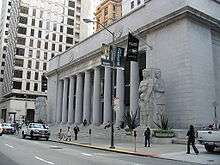Pacific Exchange

The Pacific Exchange was, until 2001, a regional stock exchange with a main exchange floor and building in San Francisco, California, USA and a branch in Los Angeles, California, USA. Its history began with the founding of the San Francisco Stock and Bond Exchange in 1882 and the Los Angeles Oil Exchange in 1889. In 1957, the two exchanges merged to create the Pacific Coast Stock Exchange, though trading floors were maintained in both cities. In 1973, The Exchange was renamed the Pacific Stock Exchange and it began trading options three years later in 1976.
In 1999, the exchange became the first U.S. stock exchange to demutualize. The trading floor in Los Angeles was closed in 2001, followed by the floor in San Francisco a year later. 2003 saw the exchange launch PCX Plus, an electronic options trading platform. By 2005, the Pacific Exchange was bought by the owner of the ArcaEx platform, Archipelago Holdings, which then merged with the New York Stock Exchange in 2006.[1] The New York Stock Exchange conducts no business operations under the name Pacific Exchange, essentially ending its separate identity. Pacific Exchange equities and options trading now takes place exclusively through the NYSE Arca (formerly known as ArcaEx) platform, an Electronic communication network (ECN), as NYSE Arca Equities and NYSE Arca Options, respectively.
The former equities trading building on the corner of Sansome and Pine Streets in the Financial District of San Francisco was sold to private developers and converted by Equinox Fitness into a fitness center. However, the options trading floor still operates in the 120-year-old Mills Building that is connected to it. This trading floor had a massive expansion in September 1984. It was again expanded in the mid-nineties beginning with a larger entrance on Montgomery Street which utilized existing spiral marble staircases. The west wall was then knocked out and the corridor behind turned into additional trading areas. The overhead monitors were stacked four rows high, twice as high as the existing trading pits, in order to maximize the use of the narrow area, although these were removed later as a result of seismic concerns and replaced with countertop flat screens. Next, an unused area behind the trade-match room was converted into six additional trading areas to accommodate the exponential growth being experienced in late nineties. Unfortunately, the dual listing of issues in August 1999, decimalization of options quotes, and technological replacement of open out-cry trading took away market share from the equity options trading floor. In spite of all of this, the options floor still is functioning today with local firms such as Casey Securities and Student Options, and nationally known firms like Goldman Sachs, maintaining a presence. Other participants maintain offices and trading facilities off the exchange floor, but still remotely partake in electronic exchange trading.
Similarly, the building and real estate directly related to the Pacific Stock Exchange in Los Angeles were slated for redevelopment into high rise condos and retail stores in early to mid-2000 but nothing ever materialized, other than a couple of temporary nightclubs operating on the old Equities trading floor.
The options floor can be seen as it was in the mid-eighties in the 1986 film Quicksilver. Actor Kevin Bacon was the protagonist, a market maker who 'blew out' his trading account and became a bicycle messenger while he redeemed himself.
See also
References
- ↑ Anderson, Jenny (2005-01-04). "Market Owner Agrees to Buy Pacific Exchange". The New York Times. ISSN 0362-4331. Retrieved 2015-11-17.
External links
- "Exchange Ending an Era. Pacific is phasing out its historic stock trading floor." San Francisco Chronicle
- Footage of options floor live trading filmed by a floor broker in 1997.
- Saturday morning episode of First Cut teaching what options trading really is.